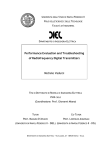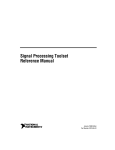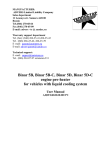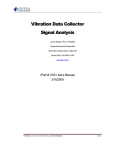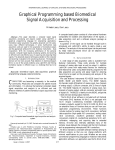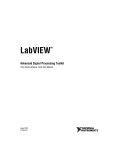Download "user manual"
Transcript
LabVIEW TM Advanced Signal Processing Toolkit Time Frequency Analysis Tools User Manual Time Frequency Analysis Tools User Manual August 2005 371552A-01 Support Worldwide Technical Support and Product Information ni.com National Instruments Corporate Headquarters 11500 North Mopac Expressway Austin, Texas 78759-3504 USA Tel: 512 683 0100 Worldwide Offices Australia 1800 300 800, Austria 43 0 662 45 79 90 0, Belgium 32 0 2 757 00 20, Brazil 55 11 3262 3599, Canada 800 433 3488, China 86 21 6555 7838, Czech Republic 420 224 235 774, Denmark 45 45 76 26 00, Finland 385 0 9 725 725 11, France 33 0 1 48 14 24 24, Germany 49 0 89 741 31 30, India 91 80 51190000, Israel 972 0 3 6393737, Italy 39 02 413091, Japan 81 3 5472 2970, Korea 82 02 3451 3400, Lebanon 961 0 1 33 28 28, Malaysia 1800 887710, Mexico 01 800 010 0793, Netherlands 31 0 348 433 466, New Zealand 0800 553 322, Norway 47 0 66 90 76 60, Poland 48 22 3390150, Portugal 351 210 311 210, Russia 7 095 783 68 51, Singapore 1800 226 5886, Slovenia 386 3 425 4200, South Africa 27 0 11 805 8197, Spain 34 91 640 0085, Sweden 46 0 8 587 895 00, Switzerland 41 56 200 51 51, Taiwan 886 02 2377 2222, Thailand 662 278 6777, United Kingdom 44 0 1635 523545 For further support information, refer to the Technical Support and Professional Services appendix. To comment on National Instruments documentation, refer to the National Instruments Web site at ni.com/info and enter the info code feedback. © 2005 National Instruments Corporation. All rights reserved. Important Information Warranty The media on which you receive National Instruments software are warranted not to fail to execute programming instructions, due to defects in materials and workmanship, for a period of 90 days from date of shipment, as evidenced by receipts or other documentation. National Instruments will, at its option, repair or replace software media that do not execute programming instructions if National Instruments receives notice of such defects during the warranty period. National Instruments does not warrant that the operation of the software shall be uninterrupted or error free. A Return Material Authorization (RMA) number must be obtained from the factory and clearly marked on the outside of the package before any equipment will be accepted for warranty work. National Instruments will pay the shipping costs of returning to the owner parts which are covered by warranty. National Instruments believes that the information in this document is accurate. The document has been carefully reviewed for technical accuracy. In the event that technical or typographical errors exist, National Instruments reserves the right to make changes to subsequent editions of this document without prior notice to holders of this edition. The reader should consult National Instruments if errors are suspected. In no event shall National Instruments be liable for any damages arising out of or related to this document or the information contained in it. EXCEPT AS SPECIFIED HEREIN, NATIONAL INSTRUMENTS MAKES NO WARRANTIES, EXPRESS OR IMPLIED, AND SPECIFICALLY DISCLAIMS ANY WARRANTY OF MERCHANTABILITY OR FITNESS FOR A PARTICULAR PURPOSE. CUSTOMER’S RIGHT TO RECOVER DAMAGES CAUSED BY FAULT OR NEGLIGENCE ON THE PART OF NATIONAL INSTRUMENTS SHALL BE LIMITED TO THE AMOUNT THERETOFORE PAID BY THE CUSTOMER. NATIONAL INSTRUMENTS WILL NOT BE LIABLE FOR DAMAGES RESULTING FROM LOSS OF DATA, PROFITS, USE OF PRODUCTS, OR INCIDENTAL OR CONSEQUENTIAL DAMAGES, EVEN IF ADVISED OF THE POSSIBILITY THEREOF. This limitation of the liability of National Instruments will apply regardless of the form of action, whether in contract or tort, including negligence. Any action against National Instruments must be brought within one year after the cause of action accrues. National Instruments shall not be liable for any delay in performance due to causes beyond its reasonable control. The warranty provided herein does not cover damages, defects, malfunctions, or service failures caused by owner’s failure to follow the National Instruments installation, operation, or maintenance instructions; owner’s modification of the product; owner’s abuse, misuse, or negligent acts; and power failure or surges, fire, flood, accident, actions of third parties, or other events outside reasonable control. Copyright Under the copyright laws, this publication may not be reproduced or transmitted in any form, electronic or mechanical, including photocopying, recording, storing in an information retrieval system, or translating, in whole or in part, without the prior written consent of National Instruments Corporation. Trademarks National Instruments, NI, ni.com, and LabVIEW are trademarks of National Instruments Corporation. Refer to the Terms of Use section on ni.com/legal for more information about National Instruments trademarks. Other product and company names mentioned herein are trademarks or trade names of their respective companies. Members of the National Instruments Alliance Partner Program are business entities independent from National Instruments and have no agency, partnership, or joint-venture relationship with National Instruments. Patents For patents covering National Instruments products, refer to the appropriate location: Help»Patents in your software, the patents.txt file on your CD, or ni.com/patents. WARNING REGARDING USE OF NATIONAL INSTRUMENTS PRODUCTS (1) NATIONAL INSTRUMENTS PRODUCTS ARE NOT DESIGNED WITH COMPONENTS AND TESTING FOR A LEVEL OF RELIABILITY SUITABLE FOR USE IN OR IN CONNECTION WITH SURGICAL IMPLANTS OR AS CRITICAL COMPONENTS IN ANY LIFE SUPPORT SYSTEMS WHOSE FAILURE TO PERFORM CAN REASONABLY BE EXPECTED TO CAUSE SIGNIFICANT INJURY TO A HUMAN. (2) IN ANY APPLICATION, INCLUDING THE ABOVE, RELIABILITY OF OPERATION OF THE SOFTWARE PRODUCTS CAN BE IMPAIRED BY ADVERSE FACTORS, INCLUDING BUT NOT LIMITED TO FLUCTUATIONS IN ELECTRICAL POWER SUPPLY, COMPUTER HARDWARE MALFUNCTIONS, COMPUTER OPERATING SYSTEM SOFTWARE FITNESS, FITNESS OF COMPILERS AND DEVELOPMENT SOFTWARE USED TO DEVELOP AN APPLICATION, INSTALLATION ERRORS, SOFTWARE AND HARDWARE COMPATIBILITY PROBLEMS, MALFUNCTIONS OR FAILURES OF ELECTRONIC MONITORING OR CONTROL DEVICES, TRANSIENT FAILURES OF ELECTRONIC SYSTEMS (HARDWARE AND/OR SOFTWARE), UNANTICIPATED USES OR MISUSES, OR ERRORS ON THE PART OF THE USER OR APPLICATIONS DESIGNER (ADVERSE FACTORS SUCH AS THESE ARE HEREAFTER COLLECTIVELY TERMED “SYSTEM FAILURES”). ANY APPLICATION WHERE A SYSTEM FAILURE WOULD CREATE A RISK OF HARM TO PROPERTY OR PERSONS (INCLUDING THE RISK OF BODILY INJURY AND DEATH) SHOULD NOT BE RELIANT SOLELY UPON ONE FORM OF ELECTRONIC SYSTEM DUE TO THE RISK OF SYSTEM FAILURE. TO AVOID DAMAGE, INJURY, OR DEATH, THE USER OR APPLICATION DESIGNER MUST TAKE REASONABLY PRUDENT STEPS TO PROTECT AGAINST SYSTEM FAILURES, INCLUDING BUT NOT LIMITED TO BACK-UP OR SHUT DOWN MECHANISMS. BECAUSE EACH END-USER SYSTEM IS CUSTOMIZED AND DIFFERS FROM NATIONAL INSTRUMENTS' TESTING PLATFORMS AND BECAUSE A USER OR APPLICATION DESIGNER MAY USE NATIONAL INSTRUMENTS PRODUCTS IN COMBINATION WITH OTHER PRODUCTS IN A MANNER NOT EVALUATED OR CONTEMPLATED BY NATIONAL INSTRUMENTS, THE USER OR APPLICATION DESIGNER IS ULTIMATELY RESPONSIBLE FOR VERIFYING AND VALIDATING THE SUITABILITY OF NATIONAL INSTRUMENTS PRODUCTS WHENEVER NATIONAL INSTRUMENTS PRODUCTS ARE INCORPORATED IN A SYSTEM OR APPLICATION, INCLUDING, WITHOUT LIMITATION, THE APPROPRIATE DESIGN, PROCESS AND SAFETY LEVEL OF SUCH SYSTEM OR APPLICATION. Contents About This Manual Conventions ...................................................................................................................vii Related Documentation..................................................................................................viii Chapter 1 Introduction to Time-Frequency Analysis Common Time-Frequency Analysis Applications ........................................................1-4 Overview of Time Frequency Analysis Tools ...............................................................1-5 Finding Example VIs.......................................................................................1-6 Related Signal Processing Tools....................................................................................1-6 Chapter 2 Understanding Linear Time-Frequency Analysis Methods Short-Time Fourier Transform ......................................................................................2-2 Window Type and Window Length ................................................................2-3 Discrete Gabor Transform and Expansion.....................................................................2-4 Adaptive Transform and Expansion ..............................................................................2-7 Comparing Linear Time-Frequency Analysis Methods ................................................2-13 Chapter 3 Understanding Quadratic Time-Frequency Analysis Methods STFT Spectrogram.........................................................................................................3-2 Reassignment Method .....................................................................................3-6 Wigner-Ville Distribution..............................................................................................3-7 Other Cohen’s Class Time-Frequency Distributions.....................................................3-10 Choi-Williams Distribution .............................................................................3-11 Cone-Shaped Distribution ...............................................................................3-13 Gabor Spectrogram ........................................................................................................3-14 Adaptive Spectrogram ...................................................................................................3-20 Spectrogram Feature Extraction ....................................................................................3-22 Mean Instantaneous Frequency .......................................................................3-23 Mean Instantaneous Bandwidth ......................................................................3-23 Group Delay ....................................................................................................3-23 Marginal Integration........................................................................................3-24 Creating Quadratic Time-Frequency Analysis Applications.........................................3-24 Comparing Quadratic Time-Frequency Analysis Methods ...........................................3-25 Calculating the Energy of a Signal at Each Time-Frequency Instant............................3-27 © National Instruments Corporation v Time Frequency Analysis Tools User Manual Contents Appendix A Technical Support and Professional Services © National Instruments Corporation vi Time Frequency Analysis Tools User Manual About This Manual This manual contains a brief introduction to time-frequency analysis, includes information about linear and quadratic methods of time-frequency analysis, and describes how to develop typical applications using the LabVIEW Time Frequency Analysis Tools. This manual requires that you have a basic understanding of the LabVIEW environment. If you are unfamiliar with LabVIEW, refer to the Getting Started with LabVIEW manual before reading this manual. This manual is not intended to provide a comprehensive discussion of time-frequency analysis. Refer to Introduction to Time-Frequency and Wavelet Transforms1 for more information about time-frequency analysis. Note Conventions The following conventions appear in this manual: » The » symbol leads you through nested menu items and dialog box options to a final action. The sequence File»Page Setup»Options directs you to pull down the File menu, select the Page Setup item, and select Options from the last dialog box. This icon denotes a note, which alerts you to important information. bold 1 Bold text denotes items that you must select or click in the software, such as menu items and dialog box options. Qian, Shie. Introduction to Time-Frequency and Wavelet Transforms. Upper Saddle River, New Jersey: Prentice Hall PTR, 2001. © National Instruments Corporation vii Time Frequency Analysis Tools User Manual About This Manual Related Documentation The following documents contain information that you may find helpful as you read this manual: • Getting Started with LabVIEW, available as a printed manual in your LabVIEW development system box or by selecting Start»All Programs»National Instruments»LabVIEW 7.1»Search the LabVIEW Bookshelf • LabVIEW User Manual, available as a printed manual in your LabVIEW development system box or by selecting Start»All Programs»National Instruments»LabVIEW 7.1»Search the LabVIEW Bookshelf • LabVIEW Help, available by selecting Help»VI, Function, & How-To Help © National Instruments Corporation viii Time Frequency Analysis Tools User Manual Introduction to Time-Frequency Analysis 1 One way to represent a signal is the time-domain waveform, which shows how the amplitude of the signal changes over time. Examples of time-varying signals include the temperature in temperature logs, stock-index profiles, electrocardiogram signals, vibration signals, and speech signals, such as the speech signal in Figure 1-1. Figure 1-1. Speech Signal The time-domain speech waveform in Figure 1-1 depicts how the sound-pressure level evolves over time. The higher the sound-pressure level at any particular time, the larger the magnitude, or the absolute value, of the signal. An important task in most speech-enhancement applications is to find the noise characteristics and then remove the noise from the speech signal. In Figure 1-1, the period from 1.4 s to 2.0 s is the silence period, when no speech is present. Any signal measured during this time frame is noise. In speech-enhancement applications, you often observe the signal during the silence periods to estimate the noise characteristics. In many speech-analysis applications, it is important to identify the spectral content of the speech signal. Notice that the time waveform in Figure 1-1 does not provide information about the spectral content of the speech signal. To determine the frequency characteristics of this speech signal, you need a way to estimate the spectral content of the signal. One possible technique is to apply the fast Fourier transform (FFT) to the signal to © National Instruments Corporation 1-1 Time Frequency Analysis Tools User Manual Chapter 1 Introduction to Time-Frequency Analysis convert the time waveform to a frequency spectrum, as shown in Figure 1-2. Figure 1-2. Power Spectrum of Speech Signal Using the FFT to transform a time-domain signal to the frequency-domain representation of the signal can help you discover information that might be hidden in the time-domain waveform. The square of the magnitude of the FFT is called the power spectrum, which characterizes how the energy of a signal is distributed in the frequency domain. The power spectrum of a speech signal can show the relative intensity of the energy of a signal at each frequency for the entire signal. However, the power spectrum of a signal for a shorter time scale can be more useful. For example, if a speech signal includes separate low-frequency utterances and high-frequency utterances, separate power spectra for each utterance can be useful. Even within a particular utterance, variations in signal characteristics might exist, so it is useful to analyze the signal with a short time scale. For example, it might be useful to separate unvoiced speech from voiced speech in a particular utterance. © National Instruments Corporation 1-2 Time Frequency Analysis Tools User Manual Chapter 1 Introduction to Time-Frequency Analysis You can use the STFT spectrogram to provide power spectra for short time scales. Figure 1-3 shows the STFT spectrogram of the speech signal in Figure 1-1 and Figure 1-2. 1 1 2 2 Onset Fundamental Frequency 3 1 3 2 3 Harmonic Frequencies Figure 1-3. STFT Spectrogram of Speech Signal In Figure 1-3, the color depicts the magnitude of the energy of the signal at time, t, and frequency, f. The spectrum from red to blue corresponds to the energy level from strongest to weakest. From the time-frequency representation in Figure 1-3, you can identify the silence period, and you can see the change in spectral content of the signal over time. You can see the time onset, the end, the fundamental frequency, and the harmonic frequencies of the two utterances in Figure 1-3. These parameters are crucial in various speech-processing applications, such as speech recognition. Compared to Figure 1-1 and Figure 1-2, the spectrogram in Figure 1-3 can better illuminate the nature of a human speech signal. Speech signal analysis is only one example application that benefits from methods other than the FFT. Time-frequency analysis is broadly useful because most signals in real-world applications have time-varying spectral content. Analyzing the time-dependent spectra enables you to better understand the signal and the associated system. The spectrogram in Figure 1-3 is only one of many proven time-frequency analysis methods. Time Frequency Analysis Tools User Manual 1-3 ni.com Chapter 1 Introduction to Time-Frequency Analysis Common Time-Frequency Analysis Applications In general, you can categorize time-frequency analysis methods into two classes: linear methods and quadratic methods. You usually use quadratic methods to analyze, classify, and detect latent features in a signal, and you usually use linear methods to reduce noise and extract signal components. Refer to Chapter 3, Understanding Quadratic Time-Frequency Analysis Methods, for more information about the quadratic methods available in the Time Frequency Analysis Tools. Refer to Chapter 2, Understanding Linear Time-Frequency Analysis Methods, for more information about the linear methods available in the LabVIEW Time Frequency Analysis Tools. One major benefit of applying a time-frequency transform to a signal is discovering the pattern of frequency changes, which often clarifies the nature of the signal. Once you identify a pattern, you can analyze and classify the pattern. For example, a pattern of harmonic drift associated with rotating machinery can indicate the working condition of a system, and a pattern of frequency changes in medical signals can indicate a patient’s health condition. Another important use of time-frequency analysis is to reduce random noise in noise-corrupted signals. For example, random noise might spread evenly across the entire time-frequency domain. The useful information, however, usually is concentrated in a relatively small region in the time-frequency domain. If you convert such a noise-corrupted signal to the time-frequency domain using a linear time-frequency transform, you might be able to extract those components in the time-frequency domain and then reconstruct the time-domain signal, which has a higher signal-to-noise ratio. Refer to Figure 2-2 and Figure 2-3 in Chapter 2, Understanding Linear Time-Frequency Analysis Methods, for more information about reducing noise. You also can use time-frequency analysis to determine if a signal has distinct time-frequency components and isolate those components for further analysis. In the time domain, you can separate the components of signals that do not overlap, such as musical notes. You cannot use the Fourier transform to separate signal components that overlap in the time domain. In the frequency domain, you can use the FFT to separate signals, such as vibration harmonics caused by a steady-state shaft imbalance. However, the different components can overlap in the frequency domain if the spectral content varies over time. With such overlapping signal components, you cannot distinguish the components in either the time domain or in the frequency domain alone. In this situation, you usually can © National Instruments Corporation 1-4 Time Frequency Analysis Tools User Manual Chapter 1 Introduction to Time-Frequency Analysis use a linear time-frequency method to distinguish the overlapping signal components. As mentioned earlier in this chapter, many real-world signals contain time-varying spectra, which means that the potential application areas of time-frequency analysis are numerous. The following list highlights a few successful application areas of time-frequency analysis: • Order analysis, such as for rotating machinery analysis You can use the LabVIEW Order Analysis Toolkit to examine dynamic signals mechanical systems generate, including rotating or reciprocating components, and to create order analysis applications for order tracking, order extraction, and tachometer signal processing. Note • Machine condition monitoring for systems associated with rotational machinery, such as power-generator systems • Audio equipment testing and characterization, such as for speakers • Speech processing, such as speech enhancement and speech recognition • Radar and sonar image enhancement • Biomedical signal processing, such as signal feature extraction • Seismological signal processing, such as detection of soil liquefaction Overview of Time Frequency Analysis Tools The Time Frequency Analysis Tools are part of the LabVIEW Advanced Signal Processing Toolkit, which also contains the Wavelet Analysis Tools, the Time Series Analysis Tools, and the Digital Filter Design Toolkit. Use the Time Frequency Analysis Tools to analyze non-stationary signals with a spectral content that slowly evolves over time, to remove noise from corrupted signals, and to analyze signals that contain time-variant spectral content. The Time Frequency Analysis Tools include VIs and Express VIs for linear and quadratic time-frequency analysis methods, including the linear discrete Gabor transform and expansion, the linear adaptive transform and expansion, the quadratic Gabor spectrogram, and the quadratic adaptive spectrogram. Refer to Chapter 2, Understanding Linear Time-Frequency Analysis Methods, for more information about the linear methods available Time Frequency Analysis Tools User Manual 1-5 ni.com Chapter 1 Introduction to Time-Frequency Analysis in the Time Frequency Analysis Tools. Refer to Chapter 3, Understanding Quadratic Time-Frequency Analysis Methods, for more information about the quadratic methods available in the Time Frequency Analysis Tools. The Time Frequency Analysis Tools also include VIs to extract features from a signal, such as the mean instantaneous frequency, the mean instantaneous bandwidth, the group delay, and the marginal integration. Refer to the Spectrogram Feature Extraction section of Chapter 3, Understanding Quadratic Time-Frequency Analysis Methods, for more information about feature extraction. Finding Example VIs The Time Frequency Analysis Tools include example VIs you can use and incorporate into the VIs that you create. You can modify an example VI to fit an application, or you can copy and paste from one or more examples into a VI that you create. You can find the examples using the NI Example Finder. Select Help»Find Examples to launch the Example Finder. You also can click the arrow on the Open button on the LabVIEW dialog box and select Examples from the shortcut menu to launch the NI Example Finder. In the Browse tab of the NI Example Finder, select Toolkits and Modules»Time Frequency Analysis to view all the available examples or use the Search tab to locate a specific example. The Application examples illustrate real-world application problems. The Getting Started examples explain some time-frequency analysis concepts, such as time-frequency resolution and cross-term interference. Related Signal Processing Tools In signal processing, you usually categorize signals into two types: stationary and non-stationary. The spectral content of stationary signals does not change over time. The spectral content of non-stationary signals changes over time. For example, the vibration signal of an engine running at a constant speed is stationary. The vibration signal of an engine at the run-up stage is non-stationary. Non-stationary signals are categorized into two types according to how the spectral content changes over time: evolutionary and transient. Evolutionary signals usually contain time-varying harmonics. The time-varying harmonics relate to the underlying periodic time-varying characteristic of the system that generates the signals. Evolutionary signals also can contain time-varying broadband spectral content. Transient signals are the short-time events in a non-stationary signal, such as peaks, edges, © National Instruments Corporation 1-6 Time Frequency Analysis Tools User Manual Chapter 1 Introduction to Time-Frequency Analysis breakdown points, and the start and end of bursts. Transient signals usually vary over time, and you typically cannot predict the future values exactly. The LabVIEW Advanced Signal Processing Toolkit contains the following tools and toolkit that you can use to perform signal analysis: • Time Frequency Analysis Tools • LabVIEW Time Series Analysis Tools • LabVIEW Wavelet Analysis Tools • LabVIEW Digital Filter Design Toolkit To extract the underlying information of a signal effectively, you need to choose an appropriate analysis tool based on the following suggestions: • For stationary signals, use the Time Series Analysis Tools or the Digital Filter Design Toolkit. LabVIEW also includes an extensive set of tools for signal processing and analysis. The Time Series Analysis Tools provide VIs for preprocessing signals, estimating the statistical parameters of signals, building models of signals, and estimating the power spectrum, the high-order power spectrum, and the cepstrum of signals. The Digital Filter Toolkit provides tools for designing, analyzing, and simulating floating-point and fixed-point digital filters and tools for generating code for DSP or FPGA targets. • For evolutionary signals, use the Time Frequency Analysis Tools. Refer to the Overview of Time Frequency Analysis Tools section of this chapter for more information about the Time Frequency Analysis Tools. • For both evolutionary signals and transient signals, use the Wavelet Analysis Tools, which include VIs and Express VIs for the continuous wavelet transform, the discrete wavelet transform, the undecimated wavelet transform, the integer wavelet transform, and the wavelet packet decomposition. The Wavelet Analysis Tools also include VIs for feature extraction applications, such as denoising, detrending, and detecting peaks and edges. Time Frequency Analysis Tools User Manual 1-7 ni.com Understanding Linear Time-Frequency Analysis Methods 2 In traditional spectral analysis, the discrete Fourier transform and the inverse discrete Fourier transform are complementary operations. The discrete Fourier transform computes a frequency-domain representation of time-domain signals. The inverse discrete Fourier transform converts the frequency-domain representation back to the time-domain representation. Similarly, the discrete Gabor transform is a linear time-frequency analysis method that computes a linear time-frequency representation of time-domain signals. The discrete Gabor expansion is the inverse operation and converts the linear time-frequency representation back to the time-domain representation. A linear time-frequency representation of a signal reveals not only the spectral content of the signal but also how the spectral content evolves over time. In many real-world applications, the signature of a signal and associated noise might not be obvious in the time domain or in the frequency domain alone but might be identified easily in the time-frequency domain. Also, because linear time-frequency domain representations are invertible, you can separate signal components or reduce noise in the time-frequency domain and then reconstruct the time-domain signal with the modified time-frequency representation. The reconstructed signal contains the signal components you want or the signal with the noise reduced. The LabVIEW Time Frequency Analysis Tools provide linear time-frequency analysis methods, including the short-time Fourier transform (STFT), the discrete Gabor transform, the discrete Gabor expansion, the adaptive transform, and the adaptive expansion. © National Instruments Corporation 2-1 Time Frequency Analysis Tools User Manual Chapter 2 Understanding Linear Time-Frequency Analysis Methods Short-Time Fourier Transform The discrete Fourier transform expresses a signal as a sum of sinusoids. Because the time duration of the sinusoids is infinite, the discrete Fourier transform of the signal reflects the spectral content of an entire signal over time but does not indicate when the spectral content occurs. However, in some cases, evaluating the spectral content of a signal over a short time scale can be useful. You can use the STFT to evaluate spectral content over short time scales. The STFT, also called the windowed Fourier transform or the sliding Fourier transform, partitions the time-domain input signal into several disjointed or overlapped blocks by multiplying the signal with a window function and then applies the discrete Fourier transform to each block. Window functions, also called sliding windows, are functions in which the amplitude tapers gradually and smoothly toward zero at the edges. Because each block occupies different time periods, the resulting STFT indicates the spectral content of the signal at each corresponding time period. When you move the sliding window, you obtain the spectral content of the signal over different time intervals. Therefore, the STFT is a function of time and frequency that indicates how the spectral content of a signal evolves over time. A complex-valued, 2-D array called the STFT coefficients stores the results of windowed Fourier transforms. The magnitudes of the STFT coefficients form a magnitude time-frequency spectrum, and the phases of the STFT coefficients form a phase time-frequency spectrum. The STFT is one of the most straightforward approaches for performing time-frequency analysis and can help you easily understand the concept of time-frequency analysis. The STFT is computationally efficient because it uses the fast Fourier transform. Without taking special care, however, the STFT is not invertible, meaning you cannot reconstruct the time-domain waveform from the STFT of a signal. For example, if you step the sliding window of the STFT without overlap, you cannot reconstruct the signal in the time domain from the STFT. The discrete Gabor transform is a special case of the STFT and is a kind of invertible algorithm. The inverse of the discrete Gabor transform is called the discrete Gabor expansion. Refer to the Discrete Gabor Transform and Expansion section of this chapter for more information about these linear time-frequency analysis methods. You can use the linear STFT method when you need the phase spectrum or when you do not need signal reconstruction. For example, the phase spectrum might be helpful in automatic speech-recognition applications. © National Instruments Corporation 2-2 Time Frequency Analysis Tools User Manual Chapter 2 Understanding Linear Time-Frequency Analysis Methods If you need only the magnitude spectrum in an application, use the quadratic STFT spectrogram method, which is the square of the linear STFT. The STFT spectrogram is one of the most popular quadratic time-frequency analysis methods because of its simplicity. Refer to the STFT Spectrogram section of Chapter 3, Understanding Quadratic Time-Frequency Analysis Methods, for more information about the STFT spectrogram. Use the TFA STFT VI to compute the STFT. Refer to the LabVIEW Help for more information about the TFA STFT VI. Window Type and Window Length The time-frequency resolution of the STFT usually is defined as the product of the time resolution and the frequency resolution. The type of window you use affects the time-frequency resolution of the STFT. The Gaussian window has the optimal time-frequency resolution. The window length also affects the time resolution and the frequency resolution of the STFT. A narrow window results in a fine time resolution but a coarse frequency resolution because narrow windows have a short time duration but a wide bandwidth. A wide window results in a fine frequency resolution but a coarse time resolution because wide windows have a long time duration but a narrow frequency bandwidth. This phenomenon is called the window effect. You cannot obtain a fine time resolution and a fine frequency resolution simultaneously using the STFT. With a time-invariant window, the STFT has the same time resolution and frequency resolution across the entire time-frequency plane. Refer to the STFT Spectrogram section of Chapter 3, Understanding Quadratic Time-Frequency Analysis Methods, for more information about the effect of the window length on signals. If you need an adaptive time resolution and frequency resolution, use the adaptive transform described in the Adaptive Transform and Expansion section of this chapter or use the wavelet transform in the Wavelet Analysis Tools. The best window length depends on the characteristics of the signal you want to analyze. The window length should be small enough so that the windowed signal block is essentially stationary over the window interval and large enough so that the Fourier transform of the windowed signal block provides a reasonable frequency resolution. If the spectral content of the signal evolves over time slowly, which does not require a fine time resolution, set the window length large. If the spectral content of the signal Time Frequency Analysis Tools User Manual 2-3 ni.com Chapter 2 Understanding Linear Time-Frequency Analysis Methods changes relatively quickly, which requires a fine time resolution, set the window length small. For example, in speech signal processing, a time-domain window length of 25 ms is common. The step size of the sliding window determines if overlap exists. If the step size is smaller than the window length, overlap exists. If the step size is greater than the window length, no overlap exists. Overlap of the sliding window makes the STFT smoother along the time axis. However, overlap requires more computation time and memory. If the signal length is large and the spectral content evolves slowly, it is not necessary to overlap the sliding window. If the signal length is small, overlap the sliding window to obtain a smoother STFT. Discrete Gabor Transform and Expansion The discrete Gabor transform is an invertible, linear time-frequency transform. The discrete Gabor expansion is the inverse of the discrete Gabor transform. The output of the discrete Gabor transform is called the Gabor coefficients. Characteristics of time-varying signals that are not obvious in the time domain or in the frequency domain alone can become clear in the time-frequency domain when you apply the discrete Gabor transform. After you extract the useful features of a signal in the time-frequency domain, you can apply the discrete Gabor expansion to obtain the time waveform with the extracted features. Similarly, after you suppress the useless components, like noise, in the time-frequency domain, you can apply the discrete Gabor expansion to obtain the time waveform with the noise suppressed. Because the discrete Gabor transform is a special case of the STFT, you must consider the effects of the window characteristics and understand how the window length and type affect the time-frequency resolution of the time-frequency representation. The window used with the discrete Gabor transform is called the analysis window. The window used with the discrete Gabor expansion is called the synthesis window. To reconstruct the time-domain signal accurately from the Gabor time-frequency representation, you must use appropriate, complementary analysis and synthesis windows. You can exchange the analysis windows and the synthesis windows, meaning that you can use the synthesis windows for the Gabor transform and use the analysis windows for the Gabor expansion. Therefore, the analysis windows and the synthesis windows are called dual windows. Usually, you first specify the synthesis © National Instruments Corporation 2-4 Time Frequency Analysis Tools User Manual Chapter 2 Understanding Linear Time-Frequency Analysis Methods window, such as a Gaussian window. Given a synthesis window, you must use the TFA Dual Window VI to compute the corresponding analysis window. You also can use the Dual Window Express VI to design the dual windows for the discrete Gabor transform and the discrete Gabor expansion interactively. Refer to the LabVIEW Help for more information about the TFA Dual Window VI and the Dual Window Express VI. Figure 2-1 shows the typical steps for creating applications using the discrete Gabor transform and the discrete Gabor expansion. Signal In Gabor Transform Time Domain Modification Time-Frequency Domain Gabor Expansion Signal Out Time Domain Figure 2-1. Using Discrete Gabor Transform and Discrete Gabor Expansion To reduce noise or separate components of a time-varying signal, you first use the discrete Gabor transform to compute the time-frequency representation of a signal, modify the time-frequency representation of the signal, and then apply the discrete Gabor expansion to reconstruct the time-domain signal with the modified time-frequency representation. Use the TFA Discrete Gabor Transform VI and the TFA Discrete Gabor Expansion VI to compute the Gabor transform and Gabor expansion. Refer to the LabVIEW Help for more information about the TFA Discrete Gabor Transform VI and the TFA Discrete Gabor Expansion VI. Masking and thresholding are the most commonly used methods to modify a signal in the time-frequency domain. A mask defines which parts of the time-frequency representation remain and which parts to set to zero. The threshold defines which parts of the time-frequency representation with magnitudes greater than the threshold remain and which parts to set to zero. The mask and the threshold are similar to filters with time-dependent specifications. This kind of application commonly is called time-varying filtering. Time Frequency Analysis Tools User Manual 2-5 ni.com Chapter 2 Understanding Linear Time-Frequency Analysis Methods Use the TFA Time Varying Filter VI and the Time Varying Filter (Thresholding) Express VI to perform time-varying filtering interactively, such as in noise reduction and feature extraction applications. Refer to the LabVIEW Help for more information about the TFA Time Varying Filter VI and the Time Varying Filter (Thresholding) Express VI. Many other methods exist to modify the time-frequency representation, for example, setting the phase of the time-frequency representation to zero or setting the magnitude of the time-frequency representation to unity. Figure 2-2 shows an example of a noisy signal that contains three chirps. Figure 2-2. Time-Frequency Representation of Noisy Chirps The color corresponds to the magnitude of the Gabor coefficients from the discrete Gabor transform. The color spectrum from red to blue corresponds to the magnitude from maximum to minimum. The Gabor coefficients that correspond to the chirps have a higher magnitude and are concentrated in a relatively small region in the time-frequency domain. The Gabor coefficients that correspond to the noise have a lower magnitude and are spread over the entire time-frequency domain. By applying a thresholding operation, you can preserve the Gabor coefficients that correspond to the chirps and reduce to zero the Gabor coefficients that correspond to noise. The Time Varying Filter (Thresholding) Express VI reconstructs the denoised chirps from these modified Gabor coefficients by using the discrete Gabor expansion, as shown in Figure 2-3. © National Instruments Corporation 2-6 Time Frequency Analysis Tools User Manual Chapter 2 Understanding Linear Time-Frequency Analysis Methods Figure 2-3. Denoised Chirps Refer to the Offline Noise Reduction with Time Varying Filter VI in the examples\Time Frequency Analysis\TFAApplications.llb for an example of using the Time Varying Filter (Thresholding) Express VI. Adaptive Transform and Expansion You can use the inverse Fourier transform and the discrete Gabor expansion to express signals as a linear combination of a series of elementary functions. For example, the inverse discrete Fourier transform expresses a signal as the linear combination of sinusoids in which the weight of each elementary sinusoid is the corresponding discrete Fourier coefficient. The discrete Gabor expansion expresses a signal as the linear combination of windowed sinusoids with Gabor transform coefficients. Like the discrete Gabor transform, the adaptive expansion expresses a signal as a linear combination of Gaussian-windowed, linear-chirp functions called chirplets. The adaptive transform, also called the adaptive chirplet decomposition, computes the weight for each elementary chirplet. Because the sinusoid function is a subset of the chirplet, the adaptive transform is more powerful than the Gabor transform but generally requires more computing time. The adaptive transform and the adaptive expansion are unique to the Time Frequency Analysis Tools. You also can consider the elementary functions that the discrete Gabor expansion uses, such as Gaussian-windowed, complex-sinusoid functions or complex, frequency-modulated Gaussian functions, as being a set of time-shifted and frequency-modulated versions of a single prototype function. Time Frequency Analysis Tools User Manual 2-7 ni.com Chapter 2 Understanding Linear Time-Frequency Analysis Methods Frequency The time centers and frequency centers of the elementary functions used in a particular Gabor transform application are discrete and form an equally sampled grid in the time-frequency domain, as shown in Figure 2-4. n (0,0) dM Time Figure 2-4. Equally Sampled Grid In Figure 2-4, the intersection indicates the time and frequency the window represents. If the time-frequency center of a signal component is not aligned with the time-frequency sampling grid, some spectral energy from that signal component might spread erroneously to adjacent points in the time-frequency plane. This energy leakage can distort the resulting time-frequency spectrum and introduce confusing artifacts in the spectrum. Therefore, the discrete Gabor transform and the discrete Gabor expansion are not always the best way to analyze time-varying signals. The elementary functions of the adaptive expansion are time-varying signals themselves with spectral content that changes linearly over time. The time centers and the frequency centers of the chirplets are not limited to a grid in the time-frequency plane, and they can be any real value. Also, the window lengths of all the chirplets do not need to be the same. Therefore, the adaptive expansion can have a finer time-frequency resolution and express time-varying signals more accurately. The matching pursuit method is a commonly used implementation of the adaptive transform that uses a set of elementary functions called a dictionary. The dictionary size in the matching pursuit algorithm determines the speed and accuracy of the resulting analysis. A small dictionary requires less computing time but has poorer accuracy. A large dictionary results in better accuracy but requires more computing time. © National Instruments Corporation 2-8 Time Frequency Analysis Tools User Manual Chapter 2 Understanding Linear Time-Frequency Analysis Methods The TFA Adaptive Transform VI provides an implementation of the adaptive transform that is more efficient and accurate than the matching pursuit method. This implementation uses the matching pursuit method with a small dictionary size as a coarse estimation step and then follows with a refinement step to achieve an accurate estimation. The small dictionary size and refinement step make the adaptive transform in the Time Frequency Analysis Tools more efficient and accurate. Refer to the LabVIEW Help for more information about the TFA Adaptive Transform VI. The adaptive transform is used widely in applications, such as radar and sonar signal processing, that need to accurately estimate parameters of signals with time-variant spectra, especially signals that contain chirplets. After you detect the adaptive chirplets in a signal, you also can use adaptive chirplets to improve the performance of some pattern-recognition applications. Figure 2-5 shows the typical steps to create an adaptive transform and adaptive expansion application. Signal In Adaptive Transform Filtering Adaptive Expansion Signal Out Decision Making Time Domain Time-Frequency Domain Time Domain Figure 2-5. Using Adaptive Transform and Adaptive Expansion Usually, you use the adaptive transform to compute the magnitudes and parameters of chirplets, select the chirplets that you need for the application, and then apply the adaptive expansion to reconstruct the signal. In some applications, you might use the parameters of chirplets to make a decision before the expansion. Time Frequency Analysis Tools User Manual 2-9 ni.com Chapter 2 Understanding Linear Time-Frequency Analysis Methods The white line in Figure 2-6 represents the real parts of a complex-valued signal from a pulse radar receiver, and the red line in Figure 2-6 represents the imaginary parts of the signal. Figure 2-6. Complex Signal from Pulse Radar Receiver Though not apparent in Figure 2-6, this signal contains three signals—the target signature signal and two instances of strong interference from sea clutter, which is the radar signal reflected off of surface sea waves. The interference signal is much stronger than the target signature signal so you cannot see the target signature in the time-domain representation in Figure 2-6. The goal of this application is to remove the interference signal and extract the target signature signal. Because the target signature signal is a time-varying chirp signal, first observe the time-frequency representation of the signal before selecting a signal processing method to use. Figure 2-7 shows the STFT magnitude spectrum of the example signal. Figure 2-7. STFT Magnitude Spectrum of Radar Signal in Figure 2-6 © National Instruments Corporation 2-10 Time Frequency Analysis Tools User Manual Chapter 2 Understanding Linear Time-Frequency Analysis Methods The color corresponds to the magnitude of the STFT coefficients. The color spectrum from red to blue corresponds to the magnitude from maximum to minimum. The red stripes close to 0 Hz are the sea clutter interference. The green stripe running diagonally across the interference signal is the target signature signal. Notice that the interference signal is stronger than the target signature signal and that the interference and the target signature overlap in the time-frequency plane. A conventional time-domain fixed filter is not sufficient for separating these components. Because the spectral peak of the target signature changes over time and the spectral bandwidths of the interference vary over time, you can use the TFA Adaptive Transform VI to decompose the signal into a linear combination of chirplets. Next, you can remove the resulting chirplets with a chirp rate close to zero and a frequency less than 0.02 Hz in this example. Then you can use the TFA Adaptive Expansion VI to reconstruct the target signature, as shown in Figure 2-8. Refer to the LabVIEW Help for more information about the TFA Adaptive Transform VI and the TFA Adaptive Expansion VI. Figure 2-8. Reconstructed Target Signature with Sea Clutter Removed Compared to the interference signal in Figure 2-6, the sea clutter signal in Figure 2-8 has been suppressed up to 20 dB. Figure 2-9 shows the STFT magnitude spectrum of the extracted target signature with the interference substantially reduced. Time Frequency Analysis Tools User Manual 2-11 ni.com Chapter 2 Understanding Linear Time-Frequency Analysis Methods Figure 2-9. STFT Magnitude Spectrum of Reconstructed Target Signature Refer to the Chirplet TDR VI in the examples\Time Frequency Analysis\TFAApplications.llb for an example of using the TFA Adaptive Transform VI and the TFA Adaptive Expansion VI. If the signal you want to analyze using any linear time-frequency method contains a large constant offset or is non-negative, a single line in the vicinity of 0 Hz dominates the resulting time-dependent spectrum. In these situations, you might not be able to identify more interesting frequency patterns. To suppress the constant offset component, you can apply certain types of preprocessing, but the detrending methods for removing the constant-offset components depend on the application. No general method works in all cases. Common techniques of detrending include lowpass filtering and curve fitting. However, another technique is the wavelet transform. Refer to the Wavelet Analysis Tools User Manual for more information about the wavelet transform. © National Instruments Corporation 2-12 Time Frequency Analysis Tools User Manual Chapter 2 Understanding Linear Time-Frequency Analysis Methods Comparing Linear Time-Frequency Analysis Methods The linear time-frequency analysis method you select depends on the requirements of the application. Consider the resolution and if the method is invertible when you select a linear time-frequency analysis method. Table 2-1 compares these properties of the linear time-frequency analysis methods in the Time Frequency Analysis Tools. Table 2-1. Linear Time-Frequency Analysis Method Properties Method Resolution Invertible? STFT Affected by window type, window length No Gabor transform Affected by window type, window length Yes, using Gabor expansion Adaptive transform Adaptable to signal Yes, using Adaptive expansion Time Frequency Analysis Tools User Manual 2-13 ni.com Understanding Quadratic Time-Frequency Analysis Methods 3 In traditional spectral analysis, the discrete Fourier transform and the inverse discrete Fourier transform are complementary operations. The discrete Fourier transform computes a frequency-domain representation of time-domain signals. The inverse discrete Fourier transform converts the frequency-domain representation back to the time-domain representation. One important application of the Fourier transform is computing the power spectrum of a signal. The power spectrum presents the energy of a signal as a function of frequency. You can use the power spectrum to detect harmonics of a signal and to examine the frequency response of a system when the spectral content does not change over time. Because the power spectrum usually is estimated by the square of the Fourier transform, the power spectrum is considered a quadratic frequency analysis method. For signals with spectral content that changes over time, the quadratic time-frequency analysis methods compute the energy of a signal as a function of time and frequency, resulting in a quadratic time-frequency representation of the signal. Because a quadratic time-frequency representation approximately describes the energy density of a signal in the time-frequency domain, the time-frequency representation is called a distribution or a spectrogram. The LabVIEW Time Frequency Analysis Tools documentation refers to distributions and spectrograms as spectrograms. You can use the Time Frequency Analysis Tools to display a spectrogram in an intensity graph as a color map, from which you can determine the spectral content of a signal and how the spectral content evolves over time. You also can save the time-dependent 2D array to a text file for use in another software environment. The resulting text file contains only Z values and does not retain the time axis information or the frequency axis information. Use the TFA Get Time and Freq Scale Info VI to compute the time scale information and the frequency scale information of the © National Instruments Corporation 3-1 Time Frequency Analysis Tools User Manual Chapter 3 Understanding Quadratic Time-Frequency Analysis Methods time-frequency representation. Refer to the LabVIEW Help for more information about the TFA Get Time and Freq Scale Info VI. From a spectrogram, you also can extract features from a signal, such as the mean instantaneous frequency and the group delay. You can use the information in these extracted features in signal analysis, detection, estimation, and classification. Unlike the linear time-frequency analysis methods, the quadratic time-frequency analysis methods are not invertible, meaning you cannot reconstruct time-domain signals from spectrograms. If you need to reconstruct signals, use the linear time-frequency analysis methods instead. Refer to Chapter 2, Understanding Linear Time-Frequency Analysis Methods, for more information about the linear time-frequency analysis methods. The Time Frequency Analysis Tools provide the following quadratic time-frequency analysis methods: • Short-time Fourier transform (STFT) spectrogram, including the STFT-based reassignment method • Wigner-Ville distribution (WVD) • Other Cohen’s class time-frequency distributions – Choi-Williams distribution (CWD) – Cone-shaped distribution (CSD) • Gabor spectrogram • Adaptive spectrogram STFT Spectrogram The STFT spectrogram is the normalized, squared magnitude of the STFT coefficients produced by the STFT. Refer to the Short-Time Fourier Transform section of Chapter 2, Understanding Linear Time-Frequency Analysis Methods, for more information about the STFT. Normalization makes the STFT spectrogram obey Parseval’s energy-conservation property, meaning that the energy in the STFT spectrogram equals the energy in the original time-domain signal. All the quadratic time-frequency analysis methods in the Time Frequency Analysis Tools adhere to Parseval’s energy-conservation property. The STFT spectrogram, a Cohen’s class method, can be a good first choice for a quadratic time-frequency analysis method because this method is © National Instruments Corporation 3-2 Time Frequency Analysis Tools User Manual Chapter 3 Understanding Quadratic Time-Frequency Analysis Methods simple and fast. With the STFT spectrogram, you can infer if a signal is reasonably oversampled by looking for a low energy density at high frequencies in the STFT spectrogram. You also can estimate the spectral content of a signal and how the spectral content evolves over time by seeing where the energy is concentrated in the STFT spectrogram. However, other quadratic time-frequency analysis methods can provide superior time-frequency resolution. You can experiment with other methods in the Time Frequency Spectrogram Express VI to see if the STFT spectrogram unacceptably blurs the signal components you want to analyze. Refer to the LabVIEW Help for more information about the Time Frequency Spectrogram Express VI. When you have large data sets or when you do not need special features of the spectrogram, such as a fine time-frequency resolution, consider using the STFT spectrogram because it is fast and easy to use. The STFT spectrogram usually is sufficient for most applications, but it typically provides a coarse time-frequency resolution as a result of window effects that the window type and the window length determine. A narrow window results in a fine time resolution but a coarse frequency resolution because narrow windows have a short time duration but a wide bandwidth. A wide window results in a fine frequency resolution but a coarse time resolution because wide windows have a long time duration but a narrow frequency bandwidth. You cannot obtain a fine time resolution and a fine frequency resolution simultaneously using the STFT spectrogram. Use the TFA STFT Spectrogram VI to compute the STFT spectrogram. Refer to the LabVIEW Help for more information about the TFA STFT Spectrogram VI. Figure 3-1 shows a frequency hopper signal, commonly used in spread-spectrum communication systems, such as CDMA cell phones. Figure 3-1. Frequency Hopper Signal Time Frequency Analysis Tools User Manual 3-3 ni.com Chapter 3 Understanding Quadratic Time-Frequency Analysis Methods Figure 3-2 shows the ideal quadratic time-frequency representation of the example frequency hopper signal. Figure 3-2. Ideal Time-Frequency Representation of the Hopper Signal The ideal representation of the frequency of the signal in Figure 3-2 remains constant and then immediately switches to another frequency. Figure 3-3 shows the STFT spectrogram of the example frequency hopper signal with a window length of 128. Figure 3-3. STFT Spectrogram of the Hopper Signal (Window Length = 128) © National Instruments Corporation 3-4 Time Frequency Analysis Tools User Manual Chapter 3 Understanding Quadratic Time-Frequency Analysis Methods Compared to the ideal time-frequency representation in Figure 3-2, the energy distribution of the signal in Figure 3-3 is not confined to narrow lines. The STFT spectrogram in Figure 3-3 is blurry as a result of the window effects of the STFT. This blurriness is a manifestation of the coarse time-frequency resolution of the STFT spectrogram. The window length and the window type determine how the energy blurs across time and frequency and thus determine the time resolution and the frequency resolution of the STFT spectrogram. For example, a wider window length can reduce energy blurring across frequencies at the expense of increased blurring across time. A narrower window length can reduce blurring across time at the expense of increased blurring across frequencies. Figure 3-4 shows the STFT spectrogram of the example frequency hopper signal with a window length of 32. Figure 3-4. STFT Spectrogram of the Hopper Signal (Window Length = 32) Relative to the spectrogram in Figure 3-3, the energy distribution of the signal in Figure 3-4 is more spread out along the frequency axis and is more compact along the time axis, which means that the STFT spectrogram has a coarser frequency resolution but a finer time resolution when the window length is narrow. Figure 3-5 shows the STFT spectrogram of the example frequency hopper signal with a window length of 256. Time Frequency Analysis Tools User Manual 3-5 ni.com Chapter 3 Understanding Quadratic Time-Frequency Analysis Methods Figure 3-5. STFT Spectrogram of the Hopper Signal (Window Length = 256) Relative to the spectrogram in Figure 3-3, the energy distribution of the signal in Figure 3-5 is more spread out along the time axis and is more compact along the frequency axis, which means that the STFT spectrogram has a coarser time resolution but a finer frequency resolution when the window length is wide. Refer to the Window Type and Window Length section of Chapter 2, Understanding Linear Time-Frequency Analysis Methods, for more information about window lengths. Reassignment Method You can use the reassignment method to improve the time-frequency resolution of the STFT spectrogram artificially. The reassignment method automatically compresses the energy in the quadratic time-frequency representation toward the centers of gravity of the signal components to make the signal components more concentrated. The reassignment method uses the assumption that the energy of the signal components in the time-frequency representation is tightly concentrated. Using the reassignment method can help improve the time-frequency resolution of time-frequency concentrated components. However, the reassignment method also can bias the location of spectral peaks, merge distinct spectral components, falsely split compact signal components, or excessively sharpen naturally blurry signal components in the resulting time-frequency representation. Figure 3-6 shows the reassigned STFT spectrogram of the example frequency hopper signal. © National Instruments Corporation 3-6 Time Frequency Analysis Tools User Manual Chapter 3 Understanding Quadratic Time-Frequency Analysis Methods Figure 3-6. Reassigned STFT Spectrogram of the Hopper Signal Notice that the signal components in the reassigned STFT spectrogram in Figure 3-6 are less blurry in time and frequency than the STFT spectrograms in Figure 3-3, Figure 3-4, and Figure 3-5. Thus, this reassigned STFT spectrogram has a better time-frequency resolution. Wigner-Ville Distribution With the WVD quadratic time-frequency analysis method, you do not need to specify a window type like you do with the STFT spectrogram method. The WVD returns many useful signal properties for signal analysis, such as marginal properties, the mean instantaneous frequency, and the group delay. The WVD also has time and frequency shift invariance, which means that the components of two signals that are the time-shifted versions of each other look the same regardless of location in the time-frequency plane. The WVD is a Cohen’s class method. You can use the WVD on signals that have simple, widely separated signal components for which you require a fine time-frequency resolution for the corresponding time-frequency representation. The WVD also is a good choice when you want to extract signal features from a signal that contains only a single component. Use the TFA Wigner-Ville Distribution VI to compute the WVD. Refer to the LabVIEW Help for more information about the TFA Wigner-Ville Distribution VI. Time Frequency Analysis Tools User Manual 3-7 ni.com Chapter 3 Understanding Quadratic Time-Frequency Analysis Methods One serious disadvantage of the WVD is cross-term interference. Crossterms are artifacts that appear in the WVD representation between autoterms, which correspond to physically existing signal components. These crossterms falsely indicate the existence of signal components between autoterms. Figure 3-7 shows the WVD of the example frequency hopper signal. This signal has four autoterms. Each component has a different time center and a different frequency center. 1 1 1 Autoterms Figure 3-7. WVD of the Hopper Signal Compared to Figure 3-2, Figure 3-7 includes many signal components that do not correspond to the four autoterms. These artifacts are the crossterms. Notice that the crossterms are strongest at the midpoints between the autoterms and that the crossterms have a higher peak magnitude than the autoterms. The crossterms also oscillate, or form bands in the time-frequency domain, with the band spacing proportional to the distance between the autoterms. In general, as the number of autoterms increases, the autoterms and the crossterms overlap. Consequently, distinguishing the autoterms from crossterms can be challenging. The time-frequency plane includes positive frequencies and negative frequencies. Signal components present at positive frequencies in real-valued signals, such as the example frequency hopper signal, have mirrored, symmetric components at negative frequencies. The example frequency hopper signal contains four signal components at positive © National Instruments Corporation 3-8 Time Frequency Analysis Tools User Manual Chapter 3 Understanding Quadratic Time-Frequency Analysis Methods frequencies, shown in Figure 3-3, and four corresponding signal components at negative frequencies, which are not shown. The crossterms appear between autoterms at positive frequencies, between autoterms at negative frequencies, and between autoterms at positive and negative frequencies. If you convert the real-valued example frequency hopper signal into a complex-valued analytic signal by removing the autoterms at negative frequencies before you apply the WVD, you can reduce the number of crossterms in the WVD, as shown in Figure 3-8. 1 1 1 Autoterms Figure 3-8. WVD of the Analytic Hopper Signal Notice that in contrast to Figure 3-7, no crossterms appear near the horizontal axis in Figure 3-8. The analytic frequency hopper signal example has the same spectral content at positive frequencies as the original, real-valued signal but has no spectral content at negative frequencies. By converting the real-valued signal to an analytic signal, you remove the crossterms between autoterms at negative frequencies and the crossterms between autoterms at positive frequencies and negative frequencies. In addition to converting real-valued signals to analytic signals to reduce crossterms in the WVD, you can use other Cohen’s class methods and the Gabor expansion-based spectrogram, also called the Gabor spectrogram, to reduce cross-term interference. The Gabor spectrogram is a method unique to the Time Frequency Analysis Tools. Refer to the Gabor Spectrogram Time Frequency Analysis Tools User Manual 3-9 ni.com Chapter 3 Understanding Quadratic Time-Frequency Analysis Methods section of this chapter for more information about this quadratic time-frequency analysis method. Other Cohen’s Class Time-Frequency Distributions The STFT spectrogram and the WVD belong to Cohen’s class of time-frequency distributions. In addition to these two prominent Cohen’s class methods, the Time Frequency Analysis Tools also provide two other Cohen’s class methods—the CWD and the CSD. Refer to the Choi-Williams Distribution section and the Cone-Shaped Distribution sections of this chapter for more information about these quadratic time-frequency analysis methods. To understand the other Cohen’s class methods, you can start with the ambiguity function, which is equivalent to the 2D inverse Fourier transform of the WVD. Figure 3-9 shows the ambiguity function of the example frequency hopper signal. 1 1 Representation of Autoterms Figure 3-9. Ambiguity Function of the Hopper Signal In Figure 3-9, the components located at the origin of the ambiguity function plane are associated with the autoterms of the WVD. All the autoterms overlap at the origin of the ambiguity function plane. The components located away from the origin of the ambiguity function plane © National Instruments Corporation 3-10 Time Frequency Analysis Tools User Manual Chapter 3 Understanding Quadratic Time-Frequency Analysis Methods correspond to the crossterms of the WVD. Because the autoterms and the crossterms are separated in the ambiguity function plane, you can apply a mask function, also called a kernel function, to keep the autoterms and remove the crossterms. The kernel function determines how to suppress the crossterms. By selecting the appropriate kernel function, you can reduce the cross-term interference and keep some useful properties of the WVD, such as accurate marginal time integration, marginal frequency integration, mean instantaneous frequency, and group delay. Lastly, you can apply the 2D Fourier transform to the ambiguity function to obtain the smooth WVD, also called the Cohen’s class time-frequency representation. The size of the ambiguity function quadratically increases with the length of the input signal. Therefore, large signals require a long computation time and more memory. If you need to analyze large signals, divide the signal into smaller segments and analyze each segment individually. Choi-Williams Distribution The CWD uses an exponential kernel function, shown in Figure 3-10. Figure 3-10. Exponential Kernel Function The exponential kernel function has the same dimensions as the ambiguity function. The exponential kernel function suppresses the crossterms away from the horizontal axis and the vertical axis. Therefore, the CWD reduces the crossterms generated by two autoterms with different time centers and frequency centers. The exponential kernel function does not reduce the values of the ambiguity function on the horizontal axis or the vertical axis. Therefore, the CWD still possesses the useful properties of the WVD, such Time Frequency Analysis Tools User Manual 3-11 ni.com Chapter 3 Understanding Quadratic Time-Frequency Analysis Methods as accurate marginal time integration, marginal frequency integration, mean instantaneous frequency, and group delay. The CWD has a coarser time-frequency resolution than the WVD because the CWD also blurs the autoterms when the CWD reduces the crossterms. Because the exponential kernel function does not reduce the values of the ambiguity function on the horizontal axis or the vertical axis, the CWD preserves the crossterms on the horizontal axis and the vertical axis. In other words, the CWD does not suppress the crossterms that two autoterms with the same time center or frequency center generate. Use the TFA Choi-Williams Distribution VI to compute the CWD. Refer to the LabVIEW Help for more information about the TFA Choi-Williams Distribution VI. Figure 3-11 shows the CWD of the example frequency hopper signal. 1 1 1 Autoterms Figure 3-11. CWD of the Hopper Signal The exponential kernel function includes an alpha parameter to balance the crossterm suppression and the blurriness of autoterms. The larger the value of the alpha parameter, the better the crossterm suppression and the more blurry autoterms become. As alpha approaches zero, the CWD converges to the WVD. © National Instruments Corporation 3-12 Time Frequency Analysis Tools User Manual Chapter 3 Understanding Quadratic Time-Frequency Analysis Methods Cone-Shaped Distribution The CSD uses the cone-shaped kernel function, shown in Figure 3-12. Figure 3-12. Cone-Shaped Kernel Function The cone-shaped kernel function suppresses the crossterms away from the vertical axis and the origin of the ambiguity function plane. Therefore, the CSD suppresses the crossterms that two autoterms with different time centers and frequency centers generate. Additionally, the CSD suppresses the crossterms that two autoterms with the same frequency center generate. Use the TFA Cone-Shaped Distribution VI to compute the CSD. Refer to the LabVIEW Help for more information about the TFA Cone-Shaped Distribution VI. Figure 3-13 shows the CSD of the example frequency hopper signal with all crossterms suppressed. Time Frequency Analysis Tools User Manual 3-13 ni.com Chapter 3 Understanding Quadratic Time-Frequency Analysis Methods Figure 3-13. CSD of the Hopper Signal The cone-shaped kernel function does not suppress the values of the ambiguity function on the horizontal axis. Therefore, the CSD cannot reduce crossterms that two autoterms with the same time center generate. The CSD provides accurate marginal time integration and mean instantaneous frequency but does not provide accurate marginal frequency integration or group delay because the cone-shaped kernel function is not constant on the frequency shift axis. Similar to the exponential kernel function for the CWD, the cone-shaped kernel function includes an alpha parameter to balance the crossterm suppression and the blurriness of autoterms. The larger the value of the alpha parameter, the better the crossterm suppression and the more blurry autoterms become. Gabor Spectrogram Because you can decompose a signal as a linear combination of a family of elementary functions, you can consider the WVD of a signal to be the summation of the WVD of each elementary function, or autoterm, and the crossterms of each pair of elementary functions. You can use the Gabor spectrogram method to reduce the cross-term interference of the WVD. This method decomposes a signal with the Gabor expansion and then sums the WVD of each autoterm with some crossterms. Because the Gabor spectrogram method uses the Gabor expansion first and then the WVD, the Gabor spectrogram also is called the Gabor © National Instruments Corporation 3-14 Time Frequency Analysis Tools User Manual Chapter 3 Understanding Quadratic Time-Frequency Analysis Methods expansion-based spectrogram. The Gabor spectrogram also is called the time-frequency distribution series. The Gabor spectrogram is a method unique to the Time Frequency Analysis Tools. The Gabor spectrogram has a better time-frequency resolution than the STFT spectrogram method and less cross-term interference than the WVD method. The Gabor spectrogram algorithm includes simple analytic forms, and you can implement the Gabor spectrogram with interpolation filters. Therefore, the Gabor spectrogram is more efficient than the CWD and the CSD, especially with large signal lengths. However, the Gabor spectrogram usually requires more computation time than the STFT spectrogram or the WVD. Use TFA Gabor Spectrogram VI to compute the Gabor spectrogram. Refer to the LabVIEW Help for more information about the TFA Gabor Spectrogram VI. You need to select the order of the Gabor spectrogram and the window length of the Gabor spectrogram properly to balance the time-frequency resolution and the cross-term interference. For Gabor spectrograms with a low order, the window length affects the time resolution, the frequency resolution, and the cross-term interference of the Gabor spectrogram. As in the case of the STFT, a narrow window length results in a coarse frequency resolution, a fine time resolution, and severe cross-term interference between two autoterms with the same time center. A wide window length results in a fine frequency resolution, a coarse time resolution, and severe cross-term interference between two autoterms with the same frequency center. The selection of the window length in the Gabor spectrogram is much less sensitive than in the STFT spectrogram. Also, regardless of the window length you select, the Gabor spectrogram always converges to the WVD as the order increases. The order of the Gabor spectrogram balances the time-frequency resolution and the cross-term interference of the Gabor spectrogram. As the order increases, the time-frequency resolution of the Gabor spectrogram improves, but the spectrogram includes more cross-term interference and requires a longer computation time. When the order is zero, the Gabor spectrogram is non-negative and is similar to the STFT spectrogram. As the order increases, the Gabor spectrogram converges to the WVD. For most real-world applications, choose an order of two to five to balance the time-frequency resolution and cross-term suppression. Figure 3-14 shows the Gabor spectrogram of the example frequency hopper signal in Figure 3-3 when the order is 0 and the window length is 128. Time Frequency Analysis Tools User Manual 3-15 ni.com Chapter 3 Understanding Quadratic Time-Frequency Analysis Methods Figure 3-14. Gabor Spectrogram of the Hopper Signal (Order = 0, Window Length = 128) Notice that the signal in Figure 3-14 is similar to the STFT spectrogram in Figure 3-3. The Gabor spectrogram of the example frequency hopper signal in Figure 3-14 has a coarse time-frequency resolution and does not include cross-term interference. Figure 3-15 shows the Gabor spectrogram of the example frequency hopper signal in Figure 3-3 when the order is 20 and the window length is 128. © National Instruments Corporation 3-16 Time Frequency Analysis Tools User Manual Chapter 3 Understanding Quadratic Time-Frequency Analysis Methods 1 1 1 Autoterms Figure 3-15. Gabor Spectrogram of the Hopper Signal (Order = 20, Window Length = 128) The signal in Figure 3-15 is similar to the WVD in Figure 3-7 because the Gabor spectrogram converges to the WVD as the order increases. The Gabor spectrogram of the example frequency hopper signal in Figure 3-15 has a fine time-frequency resolution and includes cross-term interference. Time Frequency Analysis Tools User Manual 3-17 ni.com Chapter 3 Understanding Quadratic Time-Frequency Analysis Methods Figure 3-16 shows the Gabor spectrogram of the example frequency hopper signal when the order is 3 and the window length is 128. Figure 3-16. Gabor Spectrogram of the Hopper Signal (Order = 3, Window Length = 128) The signal in Figure 3-16 has a higher time-frequency resolution than the STFT spectrogram and less cross-term interference than the WVD. Figure 3-17 shows a signal with three Gaussian components. The composite Gaussian signal can be a useful test signal for testing the time-frequency resolution and the cross-term interference of a time-frequency analysis algorithm because the composite Gaussian signal has compact signal components that should be very narrow on the time-frequency plane. Figure 3-17. Signal with Three Gaussian Components © National Instruments Corporation 3-18 Time Frequency Analysis Tools User Manual Chapter 3 Understanding Quadratic Time-Frequency Analysis Methods The example signal in Figure 3-17 contains one Gaussian-windowed linear chirp signal and two Gaussian-windowed sine wave signals. The linear chirp has the same time center as one of the sine waves and the same frequency center as the other sine wave, but you cannot see that in the time-domain representation in Figure 3-17. Figure 3-18 shows the Gabor spectrogram of the composite Gaussian signal example when the order is 5 and the window length is 32. 1 1 1 Autoterms Figure 3-18. Gabor Spectrogram of the Composite Gaussian Signal (Order = 5, Window Length = 32) Figure 3-19 shows the Gabor spectrogram of the composite Gaussian signal example when the order is 5 and the window length is 256. Time Frequency Analysis Tools User Manual 3-19 ni.com Chapter 3 Understanding Quadratic Time-Frequency Analysis Methods 1 1 1 Autoterms Figure 3-19. Gabor Spectrogram of the Composite Gaussian Signal (Order = 5, Window Length = 256) Notice in Figure 3-18 and in Figure 3-19 that the cross-term interference along the time axis increases with the window length and the cross-term interference along the frequency axis decreases with the window length. Adaptive Spectrogram The adaptive spectrogram method is similar to the Gabor spectrogram method. The difference is that the adaptive spectrogram uses the adaptive expansion to decompose the signal and the Gabor spectrogram uses the Gabor expansion to decompose the signal before applying the WVD. Also, the adaptive spectrogram sums only the WVD of the elementary functions, or autoterms, and ignores the crossterms between every two elementary functions. The adaptive spectrogram has a fine and adaptive time-frequency resolution because the elementary functions of the adaptive expansion have a fine and adaptive time-frequency resolution. The time-frequency resolution of the adaptive transform adapts to the signal characteristics. The adaptive spectrogram does not include cross-term interference because it ignores all the crossterms. For example, if a signal is composed of chirplets, you can use the adaptive spectrogram to depict accurately how the chirplets appear in the time-frequency domain. © National Instruments Corporation 3-20 Time Frequency Analysis Tools User Manual Chapter 3 Understanding Quadratic Time-Frequency Analysis Methods The computation time of the adaptive spectrogram increases with the size of the data set. Also, if the signal has a nonlinear frequency modulation, the adaptive spectrogram might include too much distortion because the adaptive expansion approximates the nonlinear modulation as a linear combination of chirplets with linear frequency modulation. Use the TFA Adaptive Spectrogram VI to compute the adaptive spectrogram. Refer to the LabVIEW Help for more information about the TFA Adaptive Spectrogram VI. Figure 3-20 shows 20 superimposed, simulated chirplets designed to test the time-frequency resolution and performance of the adaptive spectrogram. You cannot distinguish the separate chirplets in the time-domain representation in Figure 3-20. Figure 3-20. Simulated Chirplet Signal Figure 3-21 shows the adaptive spectrogram of the simulated chirplet signal in Figure 3-20. Figure 3-21. Adaptive Spectrogram of the Simulated Chirplet Signal Time Frequency Analysis Tools User Manual 3-21 ni.com Chapter 3 Understanding Quadratic Time-Frequency Analysis Methods All the chirplets in Figure 3-21 are separated clearly, appear compact, and show that the adaptive spectrogram has a high and adaptive time-frequency resolution. Figure 3-22 shows the Gabor spectrogram of the simulated chirplet signal when the order is 2 and the window length is 256. 1 1 Blended Chirplets Figure 3-22. Gabor Spectrogram of the Simulated Chirplet Signal (Order = 2, Window Length = 256) The Gabor spectrogram in Figure 3-22 has a lower time-frequency resolution than the adaptive spectrogram in Figure 3-21, and some of the chirplets blend together, which prevents you from separating the two signal components. Spectrogram Feature Extraction Quadratic time-frequency analysis methods produce spectrograms, which are 2D matrixes. Interpreting 2D spectrograms quantitatively might not be straightforward. However, you can use the Time Frequency Analysis Tools to apply post-processing techniques to extract useful 1D information from spectrograms and compute the mean instantaneous frequency (MIF), the mean instantaneous bandwidth (MIB), the group delay, and the marginal integration from spectrograms. You can use these results to characterize spectrograms and to help with further feature extraction and pattern © National Instruments Corporation 3-22 Time Frequency Analysis Tools User Manual Chapter 3 Understanding Quadratic Time-Frequency Analysis Methods recognition in real-world applications. For example, you can use the MIF of ground echo signals to detect the liquefaction that might be associated with an earthquake, and you can use the MIF and MIB of Doppler ultrasound signals for noninvasive blood flow measurements. Mean Instantaneous Frequency The mean frequency of a signal describes the center of gravity of the power spectrum of the signal. The power spectrum of non-stationary signals is time dependent, and therefore the mean frequency of non-stationary signals is time dependent. The time-dependent mean frequency is called the mean instantaneous frequency. For non-stationary signals with a single frequency component or a single frequency band, the MIF describes the central frequency evolution over time. Use the TFA Mean Instantaneous Frequency VI to compute the statistical first moment of the spectrogram along the frequency axis as an estimation of the MIF. The first moment of the WVD or the first moment of the CWD is the MIF. The first moments of other quadratic time-frequency representations can provide only an approximation of the MIF. Refer to the LabVIEW Help for more information about the TFA Mean Instantaneous Frequency VI. Mean Instantaneous Bandwidth The mean bandwidth of a signal describes the spread of the power spectrum of the signal around the mean frequency. The power spectrum of non-stationary signals is time dependent, and therefore the mean bandwidth of non-stationary signals is time dependent. The time-dependent mean bandwidth is called the mean instantaneous bandwidth. Use the TFA Mean Instantaneous Bandwidth VI to compute the second moment of the spectrogram along the frequency axis as an estimation of the MIB. Refer to the LabVIEW Help for more information about the TFA Mean Instantaneous Bandwidth VI. Group Delay The time delay of a single-tone signal describes the localization of the signal in the time domain. If signal A has a larger time delay than signal B, signal A follows signal B in the time domain. The group delay is the time delay of a non-stationary signal as a function of frequency. The group delay describes the time lags among different frequencies. You also can use the group delay to measure the propagation time through a system as a function of frequency. Time Frequency Analysis Tools User Manual 3-23 ni.com Chapter 3 Understanding Quadratic Time-Frequency Analysis Methods Use the TFA Group Delay VI to compute the first moment of the spectrogram along the time axis as an estimation of the group delay. Refer to the LabVIEW Help for more information about the TFA Group Delay VI. Marginal Integration The marginal integration is the integration of the spectrogram along the time axis or the frequency axis. If the integration along the time axis equals the power spectrum of the signal, the spectrogram satisfies the marginal frequency condition. If the integration along the frequency axis equals the instantaneous power of the signal, the spectrogram satisfies the marginal time condition. The WVD and the CWD satisfy both marginal conditions. For other quadratic time-frequency analysis methods, you can consider the marginal time integration as the mean instantaneous power and the marginal frequency integration as the mean power spectrum. Use the TFA Marginal Integration VI to compute the marginal integration. Refer to the LabVIEW Help for more information about the TFA Marginal Integration VI. Creating Quadratic Time-Frequency Analysis Applications Figure 3-23 shows the typical steps for creating applications for signal analysis, detection, and classification using the quadratic time-frequency analysis method VIs. Spectrogram Signal In Quadratic VIs Feature Extraction VIs Decision Making MIF, MIB, Group Delay, Marginal Integration Figure 3-23. Typical Approach for Creating Applications Using Quadratic Time-Frequency Analysis You can use the Time Frequency Analysis VIs to compute the spectrogram of a signal, analyze the spectrogram directly, and then decide what step to take next. You also can use the spectrogram to compute other indexes, such © National Instruments Corporation 3-24 Time Frequency Analysis Tools User Manual Chapter 3 Understanding Quadratic Time-Frequency Analysis Methods as the MIF, the MIB, the group delay, and the marginal integration before deciding what step to take next. Comparing Quadratic Time-Frequency Analysis Methods The quadratic time-frequency analysis method you select depends on the requirements of the application. Consider the resolution, the negative values, the cross-term interference, and computation speed when you select a quadratic time-frequency analysis method. Table 3-1 compares these properties of the quadratic time-frequency analysis methods in the Time Frequency Analysis Tools. In general, most applications use the STFT spectrogram and the Gabor spectrogram. Time Frequency Analysis Tools User Manual 3-25 ni.com Chapter 3 Understanding Quadratic Time-Frequency Analysis Methods Table 3-1. Quadratic Time-Frequency Analysis Method Properties Resolution Includes Negative Values? STFT spectrogram Coarse No No Fast WVD Fine Yes Yes, strong Fast CWD Moderate Yes Suppresses crossterms that two autoterms with different time centers and frequency centers generate but does not suppress crossterms that two autoterms with the same time center or frequency center generate Very slow CSD Moderate Yes Suppresses crossterms that two autoterms with different time centers and frequency centers generate but does not reduce crossterms that two autoterms with the same time center generate Very slow Gabor spectrogram Fine Yes Minor when order is small Moderate Adaptive spectrogram Best for signal of chirplets No No Depends on signal length, number of components to extract Method © National Instruments Corporation Includes Cross-Term Interference? 3-26 Speed Time Frequency Analysis Tools User Manual Chapter 3 Understanding Quadratic Time-Frequency Analysis Methods Calculating the Energy of a Signal at Each Time-Frequency Instant A main motivation for the development of various time-frequency distributions, such as the STFT spectrogram, the WVD, the Gabor spectrogram, and so on, has been to describe how the energy of a signal varies with time and frequency. Currently, scientists do not know of an algorithm, except for a few special cases, that can compute the energy of a signal at each particular time-frequency instant (t, f ). Strictly speaking, the result of all quadratic time-frequency analysis algorithms, P(t, f ), is nothing more than a certain type of weighted average energy in the vicinity of the point (t, f ). Different weighting schemes lead to different algorithms with different time-frequency resolutions and other properties. Refer to Introduction to Time-Frequency and Wavelet Transforms1 for more information about weighting schemes. Without going into any detail, the following examples show the effect of different algorithms, or different weighting averages, and the resulting time-frequency distribution. 1 Qian, Shie. Introduction to Time-Frequency and Wavelet Transforms. Upper Saddle River, New Jersey: Prentice Hall PTR, 2001. Time Frequency Analysis Tools User Manual 3-27 ni.com Chapter 3 Understanding Quadratic Time-Frequency Analysis Methods Figure 3-24 shows the STFT spectrogram of a test signal that contains ten sine cycles at 10 Hz. This example uses a Hanning window. Figure 3-24. STFT Spectrogram (Hanning Window) Although the signal starts at 1 s and ends at 2 s, the STFT spectrogram in Figure 3-24 shows that energy exists before 1 s and after 2 s. You can use the Gabor spectrogram method with an order of four to suppress the energy substantially before 1 s, after 2 s, and above or below 10 Hz to achieve a better measurement, as shown in Figure 3-25. © National Instruments Corporation 3-28 Time Frequency Analysis Tools User Manual Chapter 3 Understanding Quadratic Time-Frequency Analysis Methods Figure 3-25. Gabor Spectrogram (Order = 4) Figure 3-25 shows that most of the energy of the signal now exists between 1 s and 2 s and within 10 Hz. As the order of the Gabor spectrogram increases, the energy concentration also increases, and you can come closer to achieving measurement between 1 s and 2 s and within 10 Hz. However, a Gabor spectrogram with a high order produces negative values, which can cause problems with the classical energy definition, which requires that the energy be non-negative. Time Frequency Analysis Tools User Manual 3-29 ni.com Technical Support and Professional Services A Visit the following sections of the National Instruments Web site at ni.com for technical support and professional services: • Support—Online technical support resources at ni.com/support include the following: – Self-Help Resources—For answers and solutions, visit the award-winning National Instruments Web site for software drivers and updates, a searchable KnowledgeBase, product manuals, step-by-step troubleshooting wizards, thousands of example programs, tutorials, application notes, instrument drivers, and so on. – Free Technical Support—All registered users receive free Basic Service, which includes access to hundreds of Application Engineers worldwide in the NI Developer Exchange at ni.com/exchange. National Instruments Application Engineers make sure every question receives an answer. For information about other technical support options in your area, visit ni.com/services or contact your local office at ni.com/contact. • Training and Certification—Visit ni.com/training for self-paced training, eLearning virtual classrooms, interactive CDs, and Certification program information. You also can register for instructor-led, hands-on courses at locations around the world. • System Integration—If you have time constraints, limited in-house technical resources, or other project challenges, National Instruments Alliance Partner members can help. To learn more, call your local NI office or visit ni.com/alliance. If you searched ni.com and could not find the answers you need, contact your local office or NI corporate headquarters. Phone numbers for our worldwide offices are listed at the front of this manual. You also can visit the Worldwide Offices section of ni.com/niglobal to access the branch office Web sites, which provide up-to-date contact information, support phone numbers, email addresses, and current events. © National Instruments Corporation A-1 Time Frequency Analysis Tools User Manual

























































